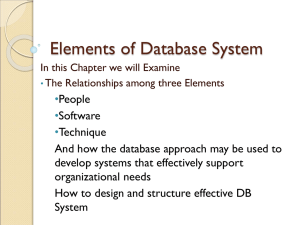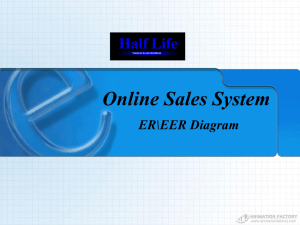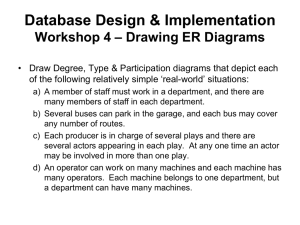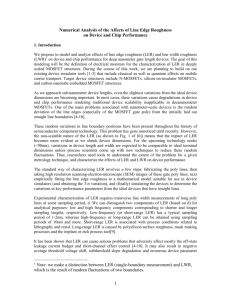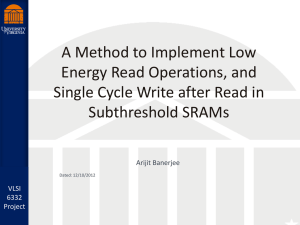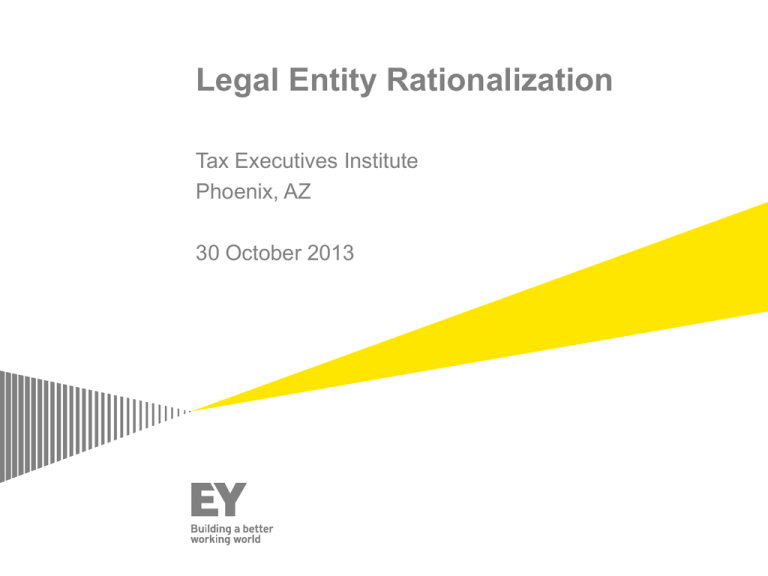
Legal Entity Rationalization
Tax Executives Institute
Phoenix, AZ
30 October 2013
IRS circular 230 disclosure
Any US tax advice contained herein was not intended or written to be
used, and cannot be used, for the purpose of avoiding penalties that may
be imposed under the Internal Revenue Code or applicable state or local
tax law provisions
These slides are for educational purposes only and are not intended, and
should not be relied upon, as accounting advice
Page 1
Agenda
►
LER and market dynamics
►
Typical business case for LER
►
Suggested approach to LER
Page 2
LER and market dynamics
Page 3
What is LER?
►Not
simply legal entity elimination or reduction of dormant entities
►Challenging
the status quo of legal entity organizational chart,
including, but not limited to:
►Legal
►Tax
►Regulatory
►Treasury
►Accounting
►Finance
►IT
►Operations
►HR/Payroll
►Effect
of market dynamics, operational changes, and acquisitions and
dispositions
►Drives
Page 4
multi-faceted benefits
Changing growth strategy and market
insights
1990-2001
►
►
►
►
►
90’s were the longest
period of growth in
U.S. history
Dot-com crash was a
sector-specific event
Capital remained
accessible
Other parts of economy
remained strong
“Blip” in overall global
economy
2001-2007
►
►
►
►
Dow Jones Industrial
Average grew by over
80%
Private equity boom
Easy access to capital
(e.g., covenant “lite”
financing)
Many organizations
focused externally and
grew through M&A
activity
►
►
►
We are targeting a reduction of ‘non-growth cost’ of
$3billion over three years – we are measuring reductions
in legal entities, headquarters, ‘rooftops’, – The fact is
that complexity is the enemy of growth and we want to
eliminate it”
Letter to Stakeholders
General Electric Company Annual Report
Page 5
2009-present
2007-2009
►
Worst recession since
the Great Depression
► Subprime mortgage
crisis
► Collapse of U.S
.housing bubble
► Global financial
crisis and collapse
of major financial
institutions
Tight credit markets
Increased regulatory
scrutiny across the
globe
Many companies focus
on survival
►
►
►
►
►
►
►
►
Credit markets remain
tight but easing
Continuing regulatory
scrutiny across the globe
Companies take more
balanced approach to
growth (organic vs.
acquisitions)
Paradigm shift in the
market –organizations
focused on internal
liquidity and growth
sources
Historically complex
organization s focus on
simplifying legal structure
Free up liquidity
Reduce costs (internal
and external)
Nimble/positioned for
growth
Typical business case
Page 6
Potential LER benefits
Potential annual administrative cost savings
►
Organizations generally seek to eliminate at least 1/3 of their active, operational entity
population
►
►
Inactive entities do not produce the sought after cost benefits.
Example—assume:
►
►
►
300 total operating entities worldwide
1/3 reduction in entity population, i.e., 100 entities to be targeted
A $25k – $50k average cost structure per entity per year
Our experience
shows:
300
LER leads to
100
eliminations
entities
Results in
200
Go-forward
entities
$2.5 – 5.0m
annual savings
►
This is administrative cost savings only, before any tax and/or other benefits which
typically crystallize during projects.
Page 7
Typical business case
Administrative cost components
Clients report an average annual carrying cost per entity of $25-50 thousand, indicating a $2.5-5m annual annuity savings for every 100 entities
eliminated.
Clients indicate administrative cost savings in the following key areas
Finance/accounting
►
►
►
►
Statutory audits
Internal accounting/account reconciliations
Auditing each entity
Management and external reporting
Hard
Soft
Tax
►
►
►
►
Information technology
►
►
►
►
►
Soft
Legal/regulatory/contractual
Initial “plug-in” of legal entities into business systems,
controls, reporting
Data warehousing of accounting and legal information
Software licensing for each entity
Duplicative IT functions, platforms, systems
►
►
Human Capital
►
Federal, state and local country income tax reporting and filings,
disclosures
Valued-added and other indirect tax filings
Net worth/capital stock tax filings
Tax basis and tax attribute monitoring, transfer pricing
Hard
►
►
►
Licensing, permits, fees and insurance
Maintaining general corporate legal documents and structure
Agreements with same or similar counterparty
Intercompany agreements and transfer pricing documentation
Liability risks
Intellectual property
Duplicative management functions
Duplicative HR systems, pensions, benefit plans and
profit-sharing plans
►
►
Duplicative management functions
Duplicative HR systems, pensions, benefit plans and profitsharing plans
Other savings can potentially include:
► More productive human capital/increased speed to closing
► Inefficient tax and legal structures removed/crystallizing tax benefits
► Significant reduction in inter-affiliate transactions is generally achieved, thereby resulting in less pressure on internal controls, business systems,
accounting functions, etc.
Other strategic benefits of LER – See next two slides
Operational synergies
Page 8
Cost avoidance
Structural alignment
Governance and control
Typical business case (continued)
Other strategic benefits of LER
Potential benefits
Operational synergies
►
►
►
Cost avoidance
►
►
►
►
Page 9
LER can potentially result in operational synergies through the thoughtful placement
of each target’s human capital, assets
and operations.
In addition to the administrative cost savings, LER thus opens an opportunity for
strategic alignment with the organization’s strategy
Potential to capture benefits with respect to:
(1) people, (2) process, (3) technology and
(4) third parties.
Avoid plugging entities that can be eliminated into performance improvement agendas,
e.g., global finance transformation, accounting and business systems, cash
management, etc.
Plugging an entity into a PI workstream (e.g., SAP implementation) can potentially
cost up to $50K per entity
► Assuming 100 eliminations: 100 x $50K = $5MM of potential savings beyond
administrative cost savings
Additionally, “speed” may potentially be captured through the avoidance of installing
unneeded entities into new systems and PI agendas.
Reduction of legal entities generally results in less pressure on internal controls and
business systems (e.g., fewer intercompany transactions, contracts, streamlined
transfer pricing, etc.)
Typical business case (continued)
Other strategic benefits of LER
Potential benefits
Structural alignment
►
►
Governance and control
►
►
►
►
Page 10
Opportunity to take advantage of changing market conditions and customer needs.
Understand new, emerging markets, product portfolios and address customer needs.
Increased transparency
Management of the population of legal entities by developing a legal entity committee
and procedures manual.
Identify the risk profile of each remaining legal entity after the LER and categorize them
as high, medium, or low.
Establish control frameworks to address relevant risks.
Suggested approach to LER
Page 11
LER process map
Project setup
Entity assessment
Step 1
Project
kick-off
Step 2
Pre-assessment workshops
Step 3
Develop BU/jurisdiction
roadmap
Passport PL
Passport PL
Step 6b
Functional step plans
Passport PL
PL = Program Leader SC = Steering Committee
Page 12
Passport SC
Merge, liquidate
or strike-off
Due diligence and implementation
Step 6a
Tax step plans
Step 4a
Local assessments
Step 6c
Validation
Passport SC
Step 7
Elimination
Step 4b
Complexity analysis
Step 4c
Future state organization
plan
Passport PL
Step 5
Implementation plan
Passport SC
Proposed project approach
OCT
NOV
DEC
JAN
FEB
MAR
APR
MAY
June
July
August
September
Kick-off
Workshops
Roadmap
Wave 1 assessment
Wave 1 implementation
planning
Wave 1 due diligence and
implementation
Wave 1 elimination
Wave 2 assessment,
Wave 2 implementation
planning
Wave 2 due diligence and
implementation
Wave 2 elimination
Page 13
Organizational jurisdictional footprint
Identification of high impact jurisdictions for initial focus
►
24
27
Most organizations have a large percentage of their legal
entity population located in a select number of operating
jurisdictions. It generally makes sense to focus on these
“high population density” jurisdictions in the early stages of
LER to
►
►
59
►
►
18
►
12
Jurisdiction
%
Total
Target
Go
Elim Forward
United States
%
United Kingdom
%
Germany
%
Brazil
%
Singapore
%
Wave 1 sub-totals
%
Page 14
This approach needs to be validated relative to an
organization’s particular facts and circumstances, regulatory
and tax profile, etc.
Wave 2 – TBD
Wave 1/High Population Jurisdictions
Entity
Count
avoid unwarranted complexity until the project is up and running
efficiently, i.e., with recurring themes, solutions, issues, and other
efficiencies identified and appropriately leveraged;
secure larger volume of entity eliminations quickly by avoiding undue
analysis of multiple jurisdictional rules and provisions for small target
sets
Help establish tangible success in the early stages of LER
Involve a smaller team of professionals so that disruptions to business
operations are minimized (see estimates of potential time allotment)
Jurisdiction
Wave 2 sub-totals
Entity
Count
Wave 3 – TBD
%
Total
Target
Elim
Go
Forward
Jurisdiction
Wave 3 sub-totals
Entity
Count
%
Total
Target
Elim
Go
Forward
Addressing stakeholder challenges
Objectivity is needed to provide “independent challenge”
►
►
►
Understand the perspectives of
your stakeholders
Deploy an efficient process to
identify, validate and resolve key
considerations to quickly meet
business objectives
Deploy an efficient process to
challenge and resolve the issues
your stakeholders encounter
An objective perspective for LER
stakeholders provides an
independent challenge to
roadblocks, and ideas to overcome
suggested blockers.
Page 15
Identify and minimize stakeholder impact
Bringing speed to save money
Step 1 – Identifying isolated elimination blockers
Canvas the business, avoiding deep-dives with any
particular stakeholder until relative inputs from across the
business are considered
►
►
►
►
Start with toughest stakeholders (usually tax, legal, regulatory) –
avoids disrupting other stakeholders
Focused conversations with stakeholders to understand
commercial realities, both internal and external
Strategize potential solutions to “one-off “ isolated objections to
legal entity eliminations
Avoids wasted time and resources, brings focus to key issues,
brings speed
Page 16
Step 2 – Identifying recurring stakeholder themes
Focus on solutions to recurring themes brings efficiency
and speed
►
►
►
Recurring stakeholder themes are identified and entities are
grouped accordingly
Strategize potential solutions to recurring themes within each
stakeholder grouping
Brings efficiency by leveraging one solution across sub-populations
of legal entities
Streamlining legal entities can help
companies manage their Capital Agenda
Page 17
EY | Assurance | Tax | Transactions | Advisory
About EY
EY is a global leader in assurance, tax, transaction and advisory services. The insights and quality services we
deliver help build trust and confidence in the capital markets and in economies the world over. We develop
outstanding leaders who team to deliver on our promises to all of our stakeholders. In so doing, we play a
critical role in building a better working world for our people, for our clients and for our communities.
EY refers to the global organization and may refer to one or more of the member firms of Ernst & Young
Global Limited, each of which is a separate legal entity. Ernst & Young Global Limited, a UK company
limited by guarantee, does not provide services to clients. For more information about our organization, please
visit ey.com.
Ernst & Young LLP is a client-serving member firm of Ernst & Young Global Limited operating in the US.
©2013 Ernst & Young LLP
All Rights Reserved.
BSC No. 1307-1103210
ey.com


